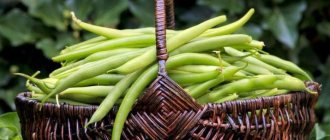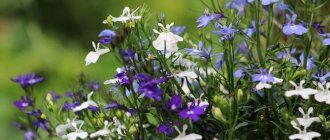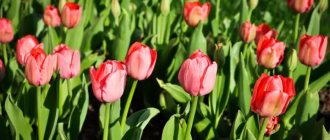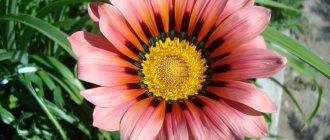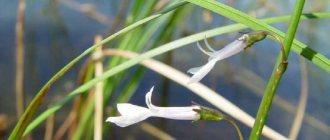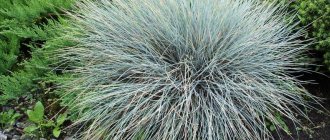Everyone knows that dogwood is a southerner. In Crimea it blooms already in February. Could gardeners from the northern regions of Russia imagine that this wonderful plant would grow in their gardens? But now this is exactly the case.
I.V. was the first to start fertilizing dogwoods. Michurin. Then the initiative was taken up by many research institutes, where they tried to extend the dogwood’s dormant period and shift flowering to a later date. The frost resistance of the bushes was also increased. Northern varieties bloom in late April - May and can withstand frosts down to 37°, so gardeners plant such varieties not only in the middle zone, but also in Siberia, the Urals, and the Far East.
And also take note: when it freezes, dogwood is able to restore the crown from the basal shoots.
Description of the plant
This wonderful plant belongs to the dogwood family, the genus dogwood. The most common type of dogwood in culture is the male or common dogwood. It occurs in the form of a tree 5-6 m high or a multi-stemmed shrub 3-4 m high. The leaves are simple, 3-8 cm long. The flowers are small, yellow, bisexual, collected in umbrella-shaped inflorescences. Flowering - before the leaves bloom. For better pollination in the garden, it is better to plant at least 2 copies. Fruits weighing 2-6 g, red, with juicy pulp, pleasant aroma and sweet-sour, tart, astringent taste. Ripen in late August-September. At the age of 12 years, the tree produces a harvest of 25-30 kg, at the age of 25 years - up to 100 kg.
Getting to know affordable exotics
In early spring, when the trees are just beginning to wake up, delicate flowers bloom on the dogwood branches. An intoxicating aroma emanates from them, and observers never cease to rejoice at the beauty of nature. It is this shrub that marks the change of seasons and the awakening of nature.
Dogwood is a deciduous shrub or small tree. The plant apparently received its name from the color of its unique fruits, which ripen in late August or early autumn. Translated from the Turkic language, the word “kizil” means “red”. In nature, various varieties of dogwood are found in the following areas:
- Europe;
- Asia Minor;
- China;
- Japan.
The shrub began to be cultivated in ancient Greece and Rome. To do this, gardeners selected the best options and then planted them on their plots. In the middle latitudes, all kinds of dogwood varieties were cultivated already in the 17th century. Since the then reigning king was keenly interested in exotic plants.
According to some historians, the first settlers of the American continent used dogwood to clean their teeth. The natives made arrows from its wood, and over time, household utensils.
As a rule, dogwood reaches 2.5 m in height. Its crown consists of glossy shoots of red or orange color. If a branch comes into contact with the soil, then in a short time it can take root and turn into a new bush. Numerous shoots of the plant are crowned with foliage of an opposite nature, which is colored dark green. Depending on the climatic conditions of the area where the dogwood grows, the flowering period begins at different times.
After successful pollination, fruits appear on the bush in the form of drupes, colored in:
- deep red;
- orange;
- Navy blue;
- black;
- black and blue;
- pink;
- yellow;
- purple.
Gardeners are especially impressed by the white dogwood with its elastic rind and tender flesh. Ripening occurs in August, but the fruits acquire a special taste after the first frost. They are in form:
- elongated cylindrical;
- pear-shaped;
- round;
- barrel-shaped.
In addition, different types of berries differ in their taste. Some of them are slightly dry, others are juicy. They are found with a tart taste or with a piquant sweetness.
Why is it worth planting it on the site?
Gardeners are primarily attracted to dogwood fruits, which are valuable for their nutritional and medicinal properties. And if we add to this that dogwood produces high yields, is durable, drought-resistant, unpretentious, is not affected by pests and diseases, and is decorative, then it becomes clear why this plant has been revered since ancient times and grown near houses and in gardens. The dogwood plant is very decorative due to its early and abundant flowering, dense bright green foliage, and beautiful fruits. The bushes tolerate pruning well and are resistant to dust and gases. A dogwood hedge is a godsend for a gardener.
Features of cultural cultivation
Planting and caring for dogwood will not cause much trouble if you choose the variety and location for the shrub responsibly. You should definitely plant only those varieties of dogwood that are able to grow and bear fruit in the local climate. For example, in mid-latitudes, late-ripening dogwood species will not have time to ripen before the arrival of winter, which means preference should be given to early varieties.
When choosing a place to plant a perennial, it is better to stay in the southwestern area, which meets the following requirements (where the dogwood will grow well and bear fruit abundantly):
- groundwater lies no closer than one and a half meters;
- the soil is fertile and not acidic.
It is necessary to plant dogwood at a distance of at least 5 meters from fences and trees, so that the crown can receive full lighting and the bush has room to grow.
Properties and benefits of dogwood
The rich content of biologically active substances in fruits, seeds, leaves, bark, and roots determines their high healing properties, which have long been used in folk medicine. Fresh fruits, as well as their processed products, which have astringent properties, are used for gastrointestinal disorders, colds, as a tonic and diuretic. Dogwood is used for anemia, gout, skin diseases, and metabolic disorders. Tincture of flowers, juice and infusion of fruits - as an antifever. A decoction of the bark and roots is used to treat the stomach and liver.
The nutritional value
The benefits and harms of dogwood are hidden in its composition, since the berries contain many different substances. It is worth noting that the fruits contain a lot of water, due to which the pulp always remains juicy. The berries are rich in ascorbic acid and are significantly superior to black currants in the content of this vitamin. Thanks to this composition, the fruits help normalize the immune system.
Fresh and dried berries contain many minerals required to normalize metabolic processes. In addition, they are required to ensure the vital functions of all human organs and tissues. Dogwood contains a lot of fiber required to normalize digestive processes and cleanse the body of toxic substances and toxins.
Where and how to plant dogwood
To get high-quality dogwood fruits in your garden plot, plant the plant in a sunny place with fertile and sufficiently moist soil. The best planting time is spring.
Place the bushes at a distance of 3-4 m from each other. The diameter of the planting hole is 80-100 cm, the depth is 70-80 cm. Fill the hole with a mixture of the top fertile layer of soil with humus and mineral fertilizers.
Planting dogwood
When planting, make sure that the root collar is level with the soil surface.
After planting and watering, mulch the tree trunk circles with peat, compost or sawdust. Vegetables can be planted between the rows of young plants.
Important care details
Dogwood, if you devote just a little time and effort to it, will thank the gardener with annual and abundant harvests. Care consists of watering, fertilizing and periodic pruning.
Watering
The dogwood's root system is superficial, so it can easily get by with natural precipitation. But in extreme heat and prolonged drought, watering is still needed, especially during fruit ripening. Once a week is enough. The norm for an adult plant is 30–40 liters.
A clear sign that the plant lacks moisture is the leaves curling up along the central vein.
Watering too much is practically the only way to definitely destroy a shrub. Dogwood does not tolerate stagnant moisture at the roots.
Water is poured not under the roots, but into the ring grooves or furrows between the bushes. If technically possible, it is advisable to organize drip irrigation. Sprinkling for dogwood is not a suitable option. Each time after the procedure, the soil in the tree trunk circle is loosened to a depth of 7–10 cm.
In order for the plant to properly prepare for winter, it needs moisture-recharging watering. You can refuse it if autumn is very rainy and cold. An adult bush consumes 70–80 liters of water. It is carried out approximately 2 weeks after the end of fruiting.
Fertilizer application
Dogwood survives and bears fruit without any fertilizing at all, but the application of fertilizers has a positive effect on productivity and decorativeness. The plant responds gratefully to both organic and mineral compositions.
- In spring, dogwood needs nitrogen for intensive growth of green mass. At the end of April, it is watered with a solution of urea, potassium sulfate, ammonium nitrate (15 g per 10 l).
- Once every 2–3 years, simultaneously with spring loosening of the soil, 2–3 buckets of humus or rotted manure are distributed in the tree trunk circle.
- Phosphorus and potassium are important for fruit ripening. In July and August, dogwood is watered with superphosphate and potassium sulfate diluted in water (20–25 g per 10 l). The natural source of these macroelements is wood ash, from which an infusion is prepared.
The yield of dogwood increases if it is planted in a substrate enriched with calcium. Therefore, once every 2–3 years, it is recommended to scatter dolomite flour, slaked lime, and powdered eggshells under the bush.
Dolomite flour is a natural soil deoxidizer that simultaneously enriches the soil with calcium.
Trimming
Dogwood does not need formative pruning. The only exception is landscape design, when the bush is given an unnatural fantasy configuration. The plant naturally has a crown of a regular, beautiful shape and is able to maintain it without outside help.
Dogwood bushes can be given an unusual shape, but they look quite nice without it
At the same time, do not forget about sanitary pruning. It is carried out annually, in early spring, before the buds “wake up”. In the process, they get rid of all the branches that have frozen, dried out, or broken under the weight of the snow. They also remove thin shoots that grow down and deep into the crown, are weak, twisted, and clearly violate the correct configuration.
For pruning, use only sharply sharpened and disinfected scissors, knives, and secateurs. If the cut diameter exceeds 0.5 cm, it is washed with a 2% solution of copper sulfate and covered with garden pitch.
The cutting tool must be clean and sharp.
Every 10–15 years, radical anti-aging pruning is carried out, getting rid of all branches aged 10 years and older. If there are too many of them, the procedure can be extended over 2-3 seasons. Dogwood tolerates it well, fully recovering next year.
On a grafted dogwood, be sure to remove all the growth below the rootstock. Otherwise, the bush will “go wild” again.
Video: how to prune dogwood correctly
Typical diseases and pests
Dogwood rarely suffers from diseases and pests. This applies to both natural varieties and breeding hybrids. If the summer is very cold and rainy, rust may develop.
The disease is easily identified by the bright saffron-colored fuzzy spots that appear on the underside of the leaves. Gradually they thicken and change color to copper or rusty. For prevention, dogwood is sprayed with a 1% solution of Bordeaux mixture or copper sulfate in early spring. Having discovered characteristic symptoms, use any fungicide (Skor, Horus, Kuprozan, Abiga-Pik). Usually 2-3 treatments are enough with an interval of 7-10 days.
To combat rust, as well as many other pathogenic fungi, copper-containing preparations are used
Among the pests, dogwood can occasionally be affected by scale insects. Colonies of insects on a bush can be mistaken for spilled flour. The affected parts of the plant turn yellow, dry out and fall off, the shoots become deformed, and the bush practically stops growing. For prevention, dogwoods are dusted with sifted wood ash, crushed chalk, colloidal sulfur, and tobacco chips every 12–15 days. When pests are detected, Mospilan and Confidor-Maxi are used.
Scale insects feed on plant sap
How to shape
Dogwood can be formed in the form of a bush with a trunk 30-50 cm high and 5-7 skeletal branches. Systematically remove root growth.
For fruit-bearing trees in early spring, regularly carry out sanitary pruning: remove dead and broken shoots, thin out, cutting out intertwined and densely located branches, striving for good illumination of the center of the crown. If you are late with pruning, juice will flow out of the wounds.
Dogwood pollination
You may find conflicting information. Some write that you need to plant only different varieties, others - two plants, maybe the same variety, others - that two plants of the same variety will pollinate each other, but only if they are not genetically related, that is, layerings were taken from more than one plant. Self-fertile varieties of dogwood exist (that is, those that do not need a pollinator, they pollinate themselves). But! Even in this case, planting another plant nearby will increase the yield. If there is no space, then you can graft two varieties into one crown. If you have seedlings growing, they will definitely be good pollinators for each other, since they are genetically different. If there is a place for grafting, then find out whether one variety or two are grafted on one rootstock (this is sometimes done). In the second case, a pollinator is not needed. And in the first case, it is better to plant another variety, it will definitely be a good pollinator.
Indications for use
Dogwood helps not only strengthen the immune system, but also improve mood and appetite. This is an excellent prophylactic agent that builds resistance to poisons. For women, this remedy helps reduce menstrual pain, as well as blood loss during childbirth.
Eating dogwood will help cleanse the liver of toxic substances. This remedy helps increase potency in men and has a diuretic effect. Berries are widely used in cosmetology as cleansing and toning masks for the skin. An infusion of the seeds will help get rid of dandruff.
Dogwood blossom
Dogwood is characterized by early flowering. In this case, flowers and ovaries are often exposed to spring frosts and die. To protect flowering bushes from frost, take the usual measures: smoking, covering with lutrasil, spunbond or other non-woven materials. But there is also a positive aspect. Since flowering lasts up to 2 weeks, unexpected frosts may not affect the harvest.
Smoking
When to Harvest
Harvest dogwood fruits in several batches, as they do not ripen at the same time. For fresh use, as well as for making juice and jam, collect the fruits at the stage of full ripeness, and for jam and compote - a little earlier. For storage, collect fruits with stalks. Unripe fruits at home ripen within 4-5 days, but do not acquire the same taste as those ripened on the tree. They can be stored in the refrigerator at a temperature of 0-4 degrees for 2-3 weeks.
Varieties
When choosing a dogwood variety for planting on a soda plot, you need to focus on local climatic conditions. Under natural conditions, this plant is a representative of the southern flora, however, some of its species can grow serenely in the northern regions.
Among garden dogwood varieties, the most popular are:
- Vladimirsky . One of the most productive varieties. From one young bush you can harvest about 40 kg of crop, and from a 20-year-old crop - 60 kg. The fruit is quite large (about 9 g on average) and looks like a small plum. Berries with thin skin and dense pulp. They have a traditional sweet and sour taste. The color is red at the beginning of ripening and darkens to dark burgundy (almost black) when the berry is completely ripe. Belongs to frost-resistant varieties. Unpretentious to soils. The harvest ripens by mid-August.
- Coral Brand . It is a somewhat unusual representative of the garden dogwood. The variety was obtained by crossing the Amber (yellow) tree and several red varieties. The berries have a pink-orange (coral) color. The flesh is pink with a sweet taste without pronounced acidity, like traditional dogwood. The average fruit weight is 5 g. An early variety, the first fruits can ripen in mid-July. Frost resistance is average.
- Firefly . Large-fruited variety with high yield. The fruits can reach 6-7 g, and about 40 kg are harvested from one 10-year-old tree. It belongs to the frost-resistant varieties of garden dogwood. The berries ripen by the end of August. They are well preserved after collection for a month. The taste is traditional sweet and sour with a bright aroma.
- Firstborn . The variety is early ripening. Frost-resistant, takes root well in the central zone. It is a large-fruited shrub, the branches of which can grow up to 3 m. The berries with an average weight of 5 g, are dense and juicy. They contain little sugar, so they are rarely consumed in their usual form.
Vladimirsky
Coral Brand
Firefly
Firstborn
How to propagate
Dogwood is propagated:
- seeds;
- basal offspring;
- layering;
- cuttings and grafting.
When propagated by seeds, all economically valuable characteristics of the mother plant are not transmitted to the offspring; this can only be ensured through vegetative propagation. Plants obtained from seed propagation begin to bear fruit in the 5th-6th year, those grown from vegetative propagation - in the 2nd-3rd year. From dogwood seeds, seedlings and rootstocks are grown for grafting.
All methods of vegetative propagation of dogwood are quite effective.
When rooting green cuttings in a greenhouse, good results can be achieved if you turn on the fogging unit.
When propagating by horizontal layering in the spring, young branches placed closer to the soil surface must be bent and laid in pre-dug grooves 15-20 cm deep. Secure the laid branch with wooden or metal pins, and bring the top to the surface and tie it vertically to a peg. To speed up root formation, cut the bark under each leaf node. Fill the furrow with fertile soil and water it. During the growing season, regularly moisten, weed and feed the cuttings. Then separate them from the mother bush and plant them in the garden.
A more common method of dogwood propagation is budding , which is carried out on 1-2-year-old seedlings of cultivated or wild dogwood. The best time is the third ten days of July - early August. It is better to oculate with two eyes.



